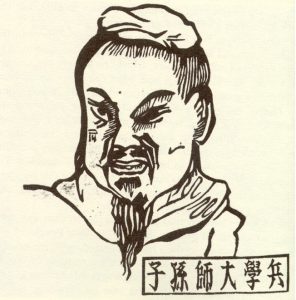The Art of War by Sun Tzu from China and Arthashastra by Kautilya rank among the finest war and political discourses were ever written, opines Tapati, in the second part of her three-part research on faces of war, exclusively for Different Truths.
In the morning we all were glued to TVs checking the latest developments on the  border. News were pouring in with pictures with jets crisscrossing the sky and vivid descriptions of our air force men taking avenge of the loss of Indian lives by terrorists at Pulwama. At the mid-morning, as I entered Tea-junction, a small crowd has already gathered discussing the latest data gathered from media. All were happy; our national mood of jubilation was shining on everyone’s face.
border. News were pouring in with pictures with jets crisscrossing the sky and vivid descriptions of our air force men taking avenge of the loss of Indian lives by terrorists at Pulwama. At the mid-morning, as I entered Tea-junction, a small crowd has already gathered discussing the latest data gathered from media. All were happy; our national mood of jubilation was shining on everyone’s face.
Our professor friend was encircled by listeners eager to know the past wisdom about war. Dr. Chatterji joined them, “Warfare exists in the world since the recorded history of human beings.
The Art of War by Sun Tzu from China and Arthashastra by Kautilya rank among the finest war and political discourses were ever written. Both have tremendous percipient elements embedded in them. Kautilya is often considered a perspicacious administrator, while Sun Tzu ranks high as a war strategist. Belonging to the oldest Indian and Chinese civilisations respectively, they also spelt out clear principles for espionage and stressed the importance of intelligence in all undertakings.
“While an angered man may again be happy, and a resentful man again be pleased, a state that has perished cannot be restored, nor can the dead be brought back to life”. ~ Sun Tzu
The Art of War was written to counsel rulers during a time when war was an ongoing and existential concern for the Chinese states. Sun Tzu highlighted the empirical nature of warfare saying, “While an angered man may again be happy, and a resentful man again be pleased, a state that has perished cannot be restored, nor can the dead be brought back to life”.
Kautilya emphasised the state’s self-interests and security above all.
Since the enemy existed both within and beyond a king’s domain, strategists like Kautilya and Manu did not advise the use of force as the primary state instrument.
An analysis of most insurgencies in the world shows that Kautilya was accurate in his belief that the greatest cause of insurgencies was societal discontent and advocates that the state should attach great importance to the wellbeing of the people, “if they become impoverished, they become greedy and rebellious.” He also stated that “an internal rebellion is more dangerous than an external threat because it is like nurturing a viper in one’s bosom.” Rebellions and insurgencies were classified based on the affected region and who were their sponsors. The ruler should augment his power by promoting the welfare of the people, for power comes from the country side, which is the source of all economic activity.
Rebellions and insurgencies were classified based on the affected region and who were their sponsors.
The similarities in the methods used today and those espoused by Kautilya are striking. We have glaring examples of sponsored insurgency which is the root cause of present conflict between India and Pakistan.
The wise ruler would seek his allies from among his neighbour’s neighbours. The goal would be an alliance system, with the conqueror at the centre: “The conqueror shall think of the circle of states as a wheel – himself at the hub and his allies, drawn to him by the spokes though separated by intervening territory, as its rim. The enemy, however strong he may be, becomes vulnerable when he is squeezed between the conqueror and his allies. See how Pakistan is under observation by Iran, Afghanistan and other states.
The enemy, however strong he may be, becomes vulnerable when he is squeezed between the conqueror and his allies. See how Pakistan is under observation by Iran, Afghanistan and other states.
Some of the Arthashastra’s most timeless observations on international relations and foreign policy are especially relevant for foreign policy today.
There are several guiding principles on foreign policy. Under the framework of these principles, six courses of action were advised by Indian policymakers:
Making Peace: This method is as one in which a state enters into an agreement with specific conditions for a period of time. For example, the states that fought against Napoleon entered into various coalitions in order to defeat him. The Western allies and the Soviet Union likewise entered into an agreement to defeat Nazi Germany, but their partnership dissolved after that goal was achieved.
Waging War: This strategy occurs when a state is more
powerful than another state and can defeat it through military strength, strategy, tactics, or internal conditions in the enemy’s country. Countless examples of this abound throughout human history.
Doing Nothing: This method is used when there is nothing to be gained from either waging war or establishing a treaty with another state. It could be a state of prolonged waiting before making a policy decision; for example, Japan’s alleged period of isolation during the Tokugawa Era. While often described as a period of isolation, Japanese rulers during this time observed the changing world order around them and determined

it was best to not get actively involved in hostilities or treaties with foreign powers during this time.
Preparing for War:This method requires building up one’s forces. This could entail intimidating the enemy or forcing them to use resources in order to build up their own forces. American military build-ups during the 1980s hurt the Soviet economy. Germany’s relatively rapid mobilisation during World War I compared to the speed of France and Russia gave Germany an initial advantage on the battlefield.
Seeking Protection: This strategy essentially entails bandwagoning with a stronger state for one’s own security. We have a lot of states aligning with World powers.
Dual Policy/Alliances: This strategy deals with multiple states at once, by binding some together with one’s own state in an alliance to fight enemy states. For example, a British alliance with France and Russia before the First World War allowed it to stave off hostilities with these states while containing Germany.”
But War is not always the only solution. Various policy makers narrated both hard power or the power of the army and treasury and soft power or the power of counsel and diplomacy.
Kautilya laid out a theory of the international system called the “circle of states,” or Raja Mandala. According to this theory, hostile states are those that border the ruler’s state, forming a circle around it. In turn, states that surround this set of hostile states form another circle around the circle of hostile states. This unique application of the Raja Mandala Theory is unprecedented in its clarity of thought and applicability even today. Moreover, he discussed the need to have more focus on soft power as compared to hard power. He stressed that the success of foreign policy does not depend purely on military power (hard power) but more on the intellectual power and moral power (soft power). “The enemy of my enemy is my friend.” The theory of a circle of states entails that every ruler within an international system will find his state at the center of its own circle of states.
…success of a foreign policy does not depend purely on military power (hard power) but more on the intellectual power and moral power (soft power).
Alliance-building through the mandala theory rather than total reliance on  indigenous military capability also reflected the preference for collaborative strategies.
indigenous military capability also reflected the preference for collaborative strategies.
Elements of this logic are found in India’s foreign policy today, which sees states such as Japan and Afghanistan as natural allies against China and Pakistan, respectively.
So, history is not only about dates or digging the graves; it contains a wealth of recommendations on a variety of situations that can be useful and practical in modern time.”
Professor ended with his usual broad smile; but people left with anxiety written on their face…. What could the reactions tomorrow on the border? India does have a number of friendly states through global diplomacy, but can a war be averted?
(To be continued)
©Tapati Sinha
Photos from the Internet





 By
By

